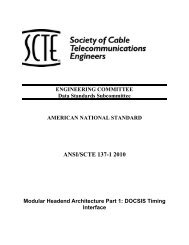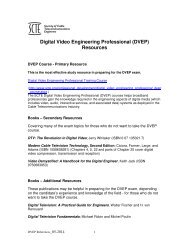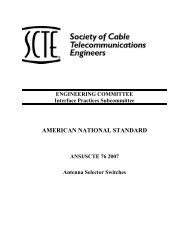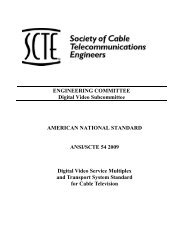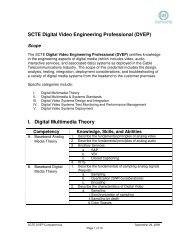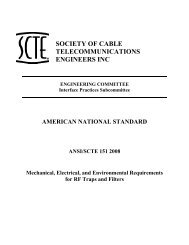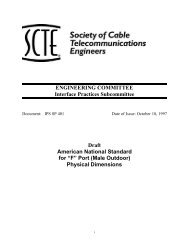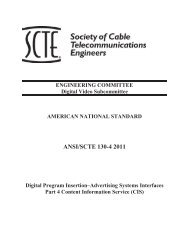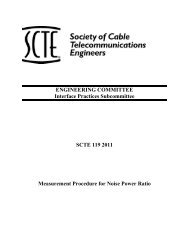Emergency Alert System (EAS): Is Your System Ready? - SCTE
Emergency Alert System (EAS): Is Your System Ready? - SCTE
Emergency Alert System (EAS): Is Your System Ready? - SCTE
Create successful ePaper yourself
Turn your PDF publications into a flip-book with our unique Google optimized e-Paper software.
December 19, 2007
• Monthly Professional Development<br />
Service<br />
– Except June<br />
• Generally “Hot Topics” or Topics of High<br />
Interest to the Industry<br />
• Vendor Agnostic – No product promotion<br />
• Free to <strong>SCTE</strong> members<br />
• Live Sessions are Recorded<br />
– Members-only benefit
• Approximately 50 minutes discussion<br />
• 10 minute Q&A at the end, however..…<br />
– Ask questions anytime throughout the session<br />
– Asking questions adds value and enhances learning<br />
– Asking questions adds value and enhances learning<br />
opportunity for you and others
! "#$%<br />
Questions?<br />
Type your question in the<br />
“Type here to chat” window.<br />
Click SEND.<br />
(Only presenters will see questions.)
& <br />
<br />
<br />
<br />
December 19, 2007
'#( )
)# * '+,<br />
Russ Byrd<br />
Director, Market Development<br />
• Responsible for Trilithic’s EAS business<br />
• 2 years with Trilithic<br />
• Previous experience in wireless industry<br />
Arthur Leisey<br />
Director of Technology for EAS<br />
• Started an EAS company that was purchased by<br />
Trilithic<br />
• Has worked with cable EAS since its inception<br />
• 8 years with Trilithic
• Overview of EAS systems<br />
• CATV architectures and their challenges<br />
• Maintenance and Monitoring of EAS<br />
delivery network<br />
• Future of EAS
• Primary national warning system<br />
– Provides for Presidential addresses in emergency or<br />
attacks<br />
– Can be used for hazards and alerts at the state and<br />
local level; Tornado, Amber <strong>Alert</strong>, Toxic Leaks, etc.<br />
• All video providers must broadcast Presidential<br />
alerts immediately; State and Local alerts may<br />
be optional currently, but many state plans are<br />
adapting toward compulsory compliance
- <br />
• National alerts are issued through the PEP<br />
(primary entry point) system; 34 radio<br />
stations covering the majority of the US<br />
• PEP stations are considered (NP) national<br />
primary<br />
• Each State’s EAS network must monitor at<br />
least one PEP<br />
• State’s have a state primary (SP), local<br />
primary sources are designated (LP)
.<br />
• All Cable TV systems are required to follow the<br />
State EAS plan; (links to plans are available at<br />
www.fcc.gov)<br />
• State plans specify the monitoring assignments<br />
for each Cable TV system; LP-1, LP-2, and any<br />
appropriate state or local relay frequencies<br />
• Cable TV systems may also be required as a<br />
part of a local franchise agreement to provide<br />
local access; i.e. police or emergency<br />
management
-(+- /' <br />
• NWS issues more than 80% of all alerts handled<br />
by the EAS network<br />
• Most states require Cable TV systems to monitor<br />
their local NOAA radio station<br />
• NOAA uses SAME protocol for hazard alerts; i.e.<br />
TOR tornado, FFW flash flood warning<br />
• NOAA uses FIPS (Federal Information<br />
Processing Standard) codes to designate the<br />
affected EAS geographic zones, i.e. counties
! 0 ' <br />
/#<br />
• Presidential <strong>Alert</strong> issued; FEMA activates the<br />
PEP system<br />
• Transmitters come under government control, a<br />
Presidential message is sent out; an EAN code,<br />
alert tones, and the audio message<br />
• The EAN is passed from the PEP to SR (State<br />
Relay) or SP to LP to Cable <strong>System</strong> to customer<br />
TV<br />
• An EAS End Of Message (EOM) is sent out, the<br />
EAS network passes the message, and the<br />
programming returns to normal
(!<br />
Indiana<br />
Washington DC<br />
FEMA<br />
PE<br />
P<br />
SP<br />
SR<br />
LP-2<br />
PE<br />
P<br />
INDY<br />
Cable<br />
PE<br />
P<br />
LP-1<br />
NOAA
• The EAS testing plan includes RMT, Required Monthly<br />
Test, and RWT, Required Weekly Test<br />
• RMT – issued by state designated stations and passed<br />
through by Cable TV system includes all four elements<br />
of an EAS message; digital header signal, two-tone<br />
attention signal, audio message, and digital EOM signal<br />
• Time limit for retransmission of RMT is 60 minutes<br />
• SECC State <strong>Emergency</strong> Communications Committee<br />
determines the EAS sources and the monitoring plan;<br />
also set date and times for RMT<br />
• RWT – issued by each Cable TV system and must be<br />
random and includes digital header and EOM signal
10<br />
• A Complete EAS Solution includes;<br />
– Encoder/Decoder – FCC certified<br />
– Radios – AM,FM,NOAA<br />
– Character Generator<br />
– NIC (Network Card) and/or phone MODEM<br />
– Distribution Equipment;<br />
• Analog – IF system or Comb generator<br />
• Digital – IP messages to devices directly (or RS-232 adaptation)
! 0 10<br />
/#<br />
• The EAS dedicated radios constantly monitor AM or FM<br />
transmissions for EAS Header FSK interruption.<br />
• The EAS Header consists of 3 bursts of FSK data and is<br />
followed by an attention tone and the spoken message<br />
• The Encoder/Decoder processes the alert information<br />
and records the audio for playback<br />
• The processing includes verification of valid alert,<br />
priority, and location<br />
• The alert is then encoded and distributed to the<br />
appropriate devices; set-top servers, edge decoders,<br />
cable cards
2 3
' '<br />
4 -! <br />
• Cable TV providers are planning systems<br />
covering large geographic<br />
– Multiple FIPS codes, LP1 & LP2’s, multiple size and<br />
capability headends<br />
• Some systems are now experiencing traffic<br />
issues, reception problems, and number of<br />
radios required to monitor exceeds capability<br />
• There is an opportunity to improve the entire<br />
EAS system in addition to facilitating the<br />
evolution of video delivery networks
2 3 /<br />
-!# <br />
• MSOs desire to receive LP-1 and LP-2 radio station via<br />
remote IP on the network, instead of the current baseband<br />
backhaul, or equivalent.<br />
• Having antennas and radios in one location and using<br />
baseband audio from leased radio lines or microwave links<br />
adds a level of uncertainty<br />
• CFR47 part 11 lists the minimum requirements for a<br />
decoder; this increases the cost for a distributed system<br />
• Trilithic has designed a solution that can meet the<br />
requirements of the market and the spirit of CFR47 part 11<br />
and improve the EAS system at the same time while<br />
lowering the cost of deployment
-!#<br />
Decoder<br />
EASyIP<br />
Network Receiver<br />
Encoder<br />
Decoder<br />
EAS Encoder/Decoder<br />
Current Configuration<br />
Encoder<br />
EAS Encoder/Decoder
10 !'-!#<br />
<br />
Receiving<br />
Antenna<br />
Network<br />
Receiver
-!# 5*<br />
• Extends the range of radio reception improving message<br />
delivery<br />
• Handshaking improves the reliability of message delivery<br />
• Allows more sources to be monitored<br />
• Lowers the cost of implementing a better system<br />
• Consistency in methods and monitoring by regional<br />
sources provides a better EAS system by moving the<br />
control to a higher level engineer or manager<br />
• Reporting capabilities are improved<br />
• Redundancy is achieved by monitoring multiple sites<br />
• Local level alerts could be provided by National<br />
Providers
-!# 6<br />
• FSK Detection and Decoding<br />
– FSK is detected to identify start and end of the EAS message,<br />
remains idle, reduces traffic<br />
• EAS Header Checking<br />
– Header is checked for validity and redundancy, and user<br />
programmed filters<br />
• EAS Audio Storage<br />
– EAS audio messages are stored on board reducing the chances<br />
of a voice message being lost<br />
• EAS Log Retention<br />
– These logs are accessible from the network for troubleshooting,<br />
verification and can be transferred to EASyPLUS to be added to<br />
the EAS log file
$ !<br />
Questions<br />
Type your question in the<br />
“Type here to chat” window.<br />
Click SEND.<br />
(Only presenters will see questions.)
• This session has been recorded<br />
• Will be available on <strong>SCTE</strong>’s Member’s<br />
Only Site within 2-3 days<br />
• To access previously recorded sessions<br />
login to:<br />
www.scte.org - with your member ID#, then scroll to the<br />
bottom of the page and select “<strong>SCTE</strong> Live Learning Archives”<br />
for a menu of previously recorded Live Learning sessions!
'#( )#<br />
Russ Byrd<br />
Director, Market Development<br />
Trilithic, Inc.<br />
rbyrd@trilithic.com<br />
Arthur Leisey<br />
Director of Technology for EAS<br />
Trilithic, Inc.<br />
aleisey@trilithic.com
'#( )
-7 8'<br />
* ' 7<br />
<br />
Bandwidth Management and the<br />
Impact of DOCSIS Channel<br />
Bonding<br />
/+9 :;+<br />



